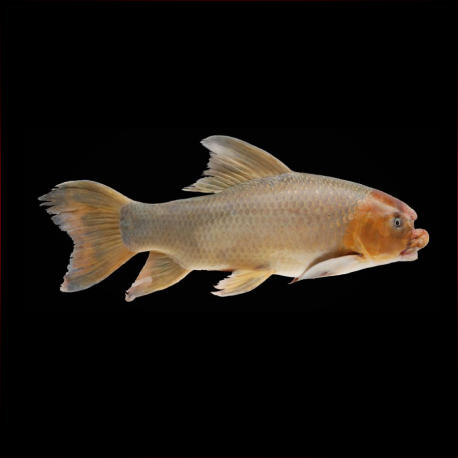More info
Datasheet
| Minimum Tank Size | 10000 litres / 2641.72 US gallons |
| Maximum Size | 55.0cm / 21.65inches |
| Temperature | 20°C / 68.00°F - 26°C / 78.80°F |
| Hardness | 2.02dgH / 36ppm - 15.02dgH / 268ppm |
| pH | 6.0-8.0 |
General Description
Describing the unique features of Incisilabeo behri, this species is easily distinguishable by a transverse notch on its head, protruding forward with tubercles covering specific areas. The color pattern consists of a yellowish to orangish-brown head and a grey to greyish-brown body. The taxonomy of this monotypic genus has shifted over the years, with the species formerly placed in Tylognathus and Bangana before being revalidated as Incisilabeo in 2011.
Aquarium Setup
For housing Incisilabeo behri, a minimum tank size of 10,000 liters is recommended, along with a large, mature filter system. Maintaining water quality is crucial, involving weekly water changes of 50-70% tank volume. Providing highly-oxygenated water with some movement is essential for the well-being of this species. Specific water conditions include a hardness of 36-268 ppm, a pH range of 6.0-8.0, and a temperature between 20-26°C (see table).
Behaviour
In aquarium settings, Incisilabeo behri may display aggression, particularly in smaller tanks where space is limited. It is imperative to consider the tank size and the presence of other tankmates to prevent any territorial issues that may arise.
Feeding and Diet
Being a specialized grazer, I. behri primarily feeds on algae and associated organisms by rasping them off surfaces like rocks using its unique mouthparts. Ensuring a diet that mimics its natural grazing behavior is essential for its overall health and well-being.
Reproduction & Dimorphism
Information specific to the reproduction and dimorphism of Incisilabeo behri is not provided in the available data, limiting insight into the species' breeding habits, sexual dimorphism, and any unique reproductive behaviors.
Habitat and Distribution
In their natural habitat, I. behri inhabits main river channels and deep tributaries with rocky substrates. They are known to form schools with other benthic fish species and undergo seasonal migrations upstream during the wet season and downstream in the dry months. These fish are native to the Mekong river system spanning southern China, Laos, Thailand, Vietnam, and Cambodia. They have also been observed in the Chao Phraya watershed, although this distribution is subject to debate. The type locality for Incisilabeo behri is the Mekong River at Kemrat, Thailand.

